Can You See Where You’re Going?
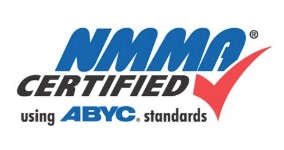
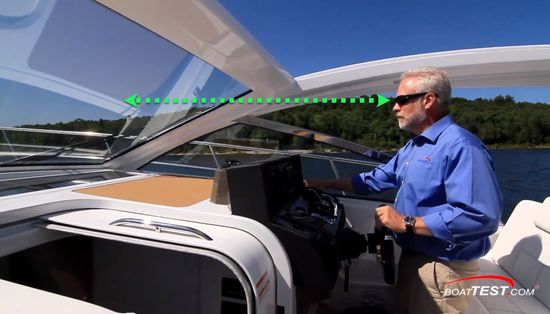
NMMA certification of boats means the helmsman is assured of good lines of sight that meet specific ABYC standards for the height of the eye from a standing and seated position. This is an important requirement and one that is not met by some boats on the market.

Boat Building Standards:
High- and Low-Eye Position at the Helm
ABYC Standards –
Notes:
- In order for this standard to be effective, the boat must be operated in a reasonable and prudent manner.
- Boats can be operated in a manner and at certain speeds causing trim and/or roll angles such that vision is obscured. A boat operator may experience some loss of vision from the helm position while operating at high trim angles during the transition between displacement and planing mode.
- This standard does not relieve the operator of the requirement to comply with the USCG Navigation Rules.
- Movable items such as persons, gear, and convertible tops are considered under the control of the boat operator and therefore are not obstructions to visibility for the purpose of this standard.
- This standard applies to all boats powered by machinery. EXCEPTION: Sailboats.
Definitions
Standing
- High Eye Position – a single point 68 inches (1.73 m) above the standing surface at the operator’s position.
- Low Eye Position – a single point 58 inches (1.48 m) above the standing surface at the operator’s position (see FIGURE 1A).
Seated
- High Eye Position – a single point 33 inches (840 mm) above the surface of the compressed seat.
- Low Eye Position – a single point 27 inches (690 mm) above the surface of the compressed seat.
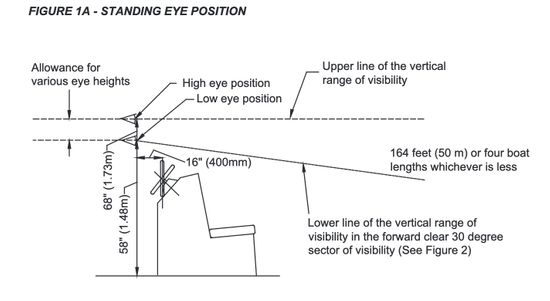
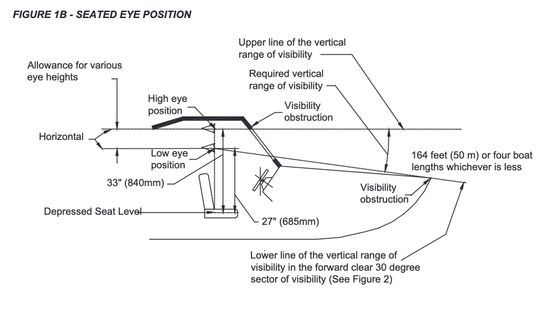
- Length Overall (LOA) – the straight-line horizontal measurement from the foremost part of the boat to the aftmost part of the boat, measured parallel to the centerline and to the waterline. Attached pulpits, rudders, outboard engine brackets, handles, railings and other similarly attached extensions are not included in the measurement. Integrally formed, molded, or welded components and appendages, such as bow pulpits, swim platforms, attachment structures for the propulsion systems, and structural rub rails installed by the builder are included in the length.
- Ready-for-use condition – craft fully equipped for the intended use, including fuel and water tanks filled. the weights for outboard engines and batteries at the highest rating for which the boat is intended to be equipped and operated.
- Vertical Range of Visibility – the range between the lowest unobstructed line of vision from the low eye position and the highest unobstructed line of vision from the high eye position (see FIGURE 1A and FIGURE 1B).
REQUIREMENTS
- The visibility requirements shall be met with the boat in a ready-for-use condition.
- At least one helm station shall comply with this standard (ABYC H-1, Field of Vision from the Helm Position).
- Additional helm stations that do not comply with the requirements of H-1 shall display a compliant label.
NOTE: An example of such a label follows.
WARNING
Visibility from this helm station is limited.
Avoid serious injury or death from collisions.
Maintain lookout as required by USCG Navigation Rules.
Read the owner’s manual.
- If a helm station is equipped with a seat and the station can comply with the requirements of H-1 from only the standing position, a label that complies with H-1.5.11 shall be displayed at the helm station.
NOTE: An example of such a label follows.
WARNING
Visibility from the seated position at this helm station is limited.
Operation from a standing position may be necessary.
Avoid serious injury or death from collisions.
Maintain a lookout as required by USCG Navigation Rules.
Read the owner’s manual.
- Controls for steering, shift, throttle and trim shall be positioned so that during use, operator hand contact can be maintained without movement of the operator’s eye below the eye position(s) for which the boat is designed. If a boat is designed to be operated from both a standing and a seated position this requirement shall be met from each position.
- Permanent tops and/or other boat structure in the vicinity of the operator shall not prevent the achievement of the visibility requirements.
NOTE: Readily removable obstructions to vision, such as convertible or camper tops, aft and side cockpit curtains, are not considered permanent structure. It is assumed that when these items are in place, caution in operation will be exercised and the operator will maintain a lookout as required by the USCG Navigation Rules.
- Windshield or windscreen glazing materials shall be in accordance with ABYC H-3, Exterior Windows, Windshields, Hatches, Doors, Port Lights, and Glazing Materials.
- Trim tabs and/or power trim, if standard equipment, may be used to meet the visibility requirements if used in accordance with the manufacturer’s instructions.
- If the use of trim tabs and/or power trim is necessary to meet the visibility requirements, instructions for the proper use of this equipment shall be included in the owner’s manual(s).
- A seat that is longitudinally and/or vertically adjustable is permitted to be used to meet the requirements of this standard.
- If a seat is installed at a helm station that is intended to comply with the standard, the surface of the compressed seat shall be no lower than 27 inches (68.58 cm) below the line established in the standard.
NOTE: To obtain consistent compression of seats to facilitate seat placement and for checking visibility, a useful tool can be prepared using a one-inch (2.54 cm) diameter dowel, hemispherical at its bottom end and fitted with thin cross rods or conspicuous markings at 27" (68.58 cm) and 33" (83.82 cm) measured from its bottom end. The use of a 20-pound (9.07 kg) force applied to the dowel resting vertically on the seat cushion, 6" (15.24 cm) forward of the projected intersection of the seat bottom and seat back along a longitudinal line through the center of the steering wheel will provide for consistency in measurements.
- Visibility from the standing position shall be attained from a standing low-eye height 58" (147.3 cm) above the standing surface at the helm.
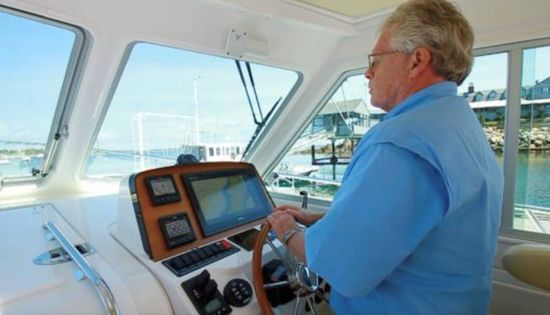
VERTICAL RANGE OF VISIBILITY
Forward clear 30-degree sector of visibility.
- The vertical range of visibility in the forward clear 30-degree sector of visibility shall extend from a horizontal line from the high eye position to a line established between a point on the surface of the water four boat lengths or 164' (50 m), whichever is less, ahead of the boat and measured from the bow, through the highest point of lower obstructed visibility within the forward clear 30-degree sector of visibility to the low eye position.
- Visibility outside of the forward clear 30-degree sector of visibility (330 degrees).
- The vertical range of visibility throughout the entire horizontal range of visibility, outside of the forward clear 30-degree sector of visibility, shall extend: from a horizontal line from the high eye position to a line from the low eye position to a point on the water’s surface at a distance no greater than four boat lengths or 164 ft (50 m), whichever is less, measured from the gunwale or stern.
- The requirements shall be met at all vessel speeds.
EXCEPTION: Operation at high trim angles during the transition between displacement and planing mode.
- The requirements shall be met from the seated position on boats designed for seated operation only; or the standing position on boats designed for standing operation only; or both the seated and standing positions if the vessel can be operated from either position, or if the boat can be operated from both the seated and standing position, but can only meet the standard from the standing position, then the helm station shall be labeled to indicate that visibility from the seated position is limited.
- The standing eye position shall be established along a vertical line that is directly behind the center of the steering wheel and 16" (40.6 cm) aft of the center of the plane of the steering wheel rim.
